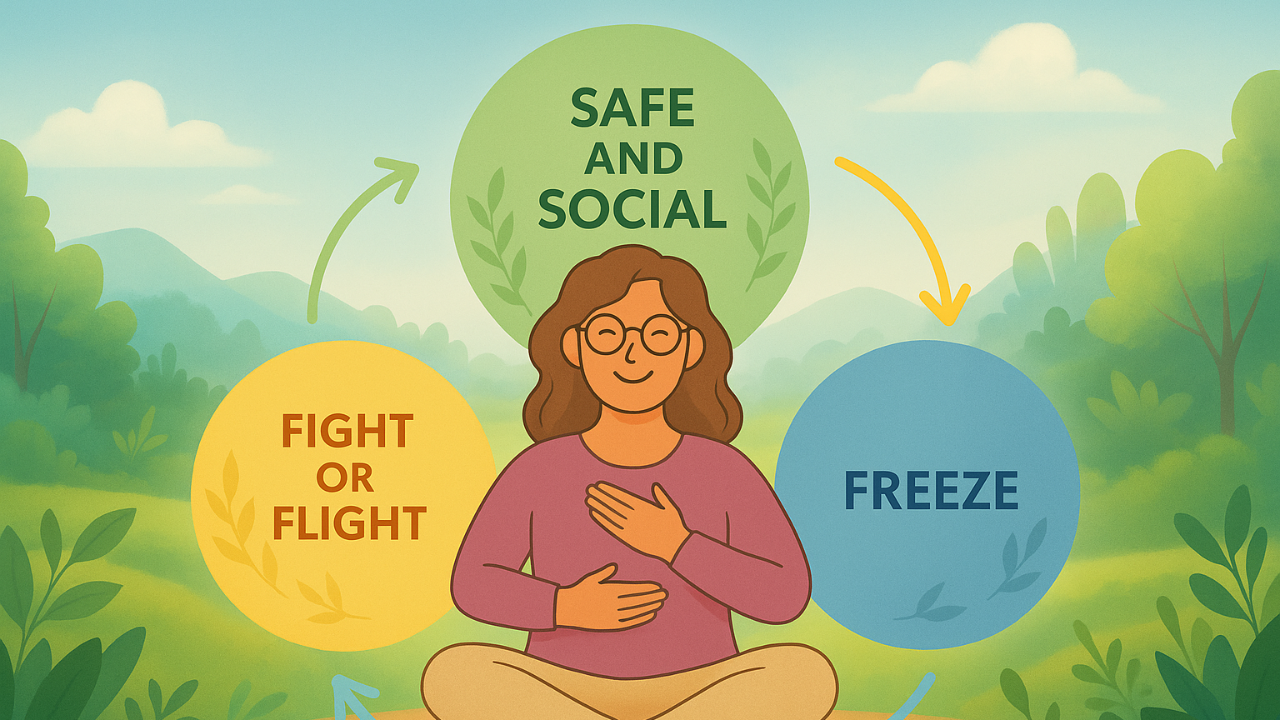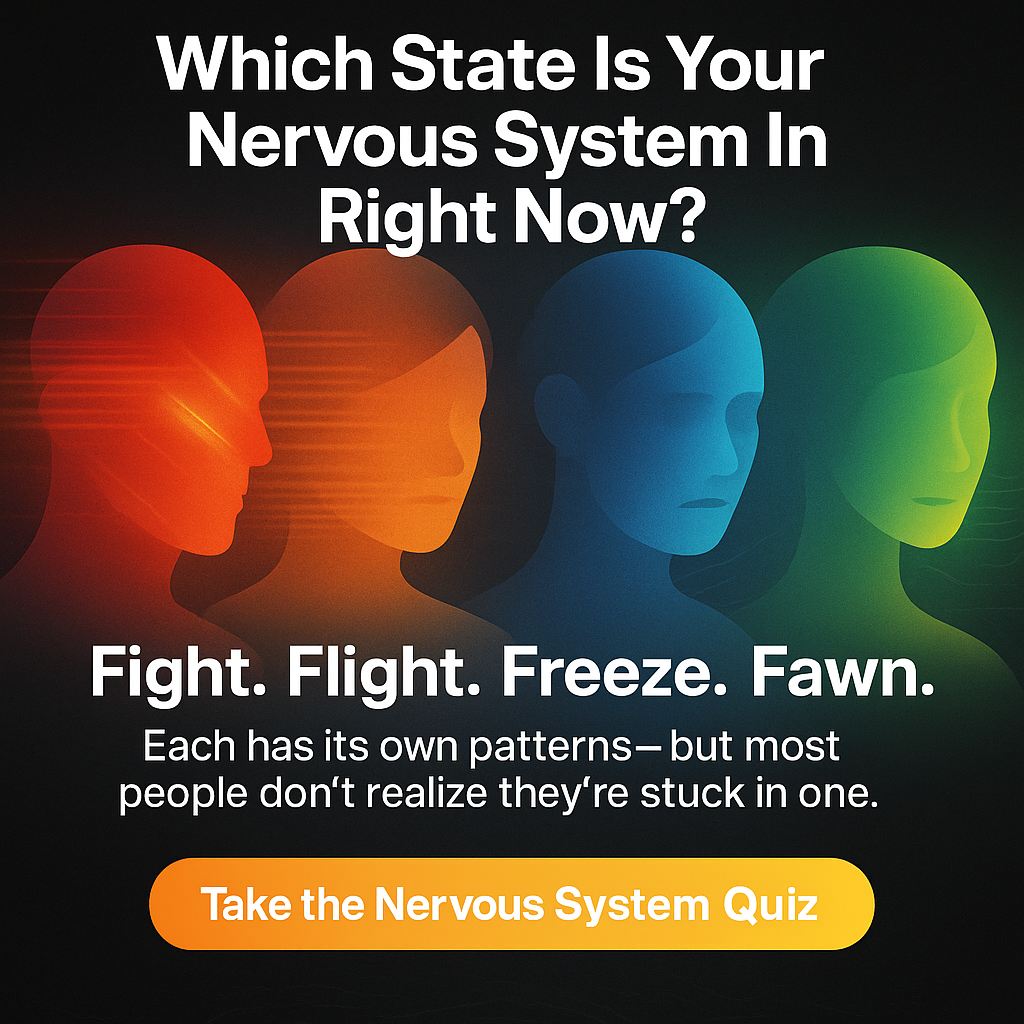
Polyvagal Theory Explained Simply
What Is Polyvagal Theory (In Simple Terms)
If you’ve ever wondered why your body tenses, freezes, or shuts down during stress, Polyvagal Theory helps explain why.
It’s a way of understanding how your nervous system constantly scans the world for safety or danger and shapes how you feel, think, and connect.
Before we go deeper, take the Stress Loop Quiz to see how your own stress patterns may be wired into your body’s automatic responses.
Quick Summary
Polyvagal Theory, developed by Dr. Stephen Porges, says your nervous system has three main states:
-
Safe and social (ventral vagal) — You feel calm, open, and connected.
-
Fight or flight (sympathetic) — You feel anxious, restless, or ready to act.
-
Shutdown or freeze (dorsal vagal) — You feel numb, tired, or disconnected.
Your body moves between these states all day long, depending on how safe or threatened you feel. This shifting can explain why you might sometimes feel grounded, and other times ready to jump out of your skin, even when nothing “bad” is happening. You can read more about that pattern here.
Why It Matters
This theory helps you see that your reactions aren’t weakness or personality flaws. They’re biological survival responses.
When your nervous system senses danger, it reacts before your mind can catch up. You might notice racing thoughts, a tight chest, or the need to escape. These are natural signs that your body is trying to protect you—even if the threat is emotional, not physical.
Many people find comfort in learning this because it replaces self-blame with understanding. It’s the same kind of insight you’ll find in How To Reset Your Nervous System After Trauma, which explains how the body learns to return to safety after chronic stress.
How To Notice Your States
Start by observing your body instead of trying to fix it. Ask yourself:
- Do I feel open and grounded, or tense and alert?
- Is my breathing deep or shallow?
- Do I want to connect with someone, or pull away?
This awareness builds what Dr. Porges calls neuroception, your body’s ability to detect safety or danger.
When you notice that your energy is speeding up or shutting down, try gentle sensory grounding. You can use this guide for grounding during panicto help your body find safety without force.
Small Daily Practices That Support Regulation
The vagus nerve is the main pathway connecting your body and brain in this process. Supporting it helps your system move from stress to calm more easily.
-
Slow exhale breathing. Try letting your out-breath be longer than your in-breath. This helps activate your body’s calming response.
-
Gentle movement. Walking, stretching, or shaking can release stuck tension.
-
Safe connection. A kind look, soothing voice, or gentle touch signals safety to your nervous system.
-
Self-massage or humming. You can try these vagus nerve massage techniques to relax your neck, face, and shoulders.
If deep breathing feels uncomfortable or makes you anxious, that’s normal. You can learn why and find gentler alternatives in this blog article.
A Simple 7-Day Practice Plan
Day 1: Notice your breathing twice today.
Day 2: When you feel tense, name three things you can see.
Day 3: Hum softly for one minute before bed.
Day 4: Walk slowly and notice your surroundings.
Day 5: Place a hand on your chest and exhale slowly.
Day 6: Text someone who feels safe to you.
Day 7: Rest without guilt, even for five minutes.
These tiny steps help your nervous system learn that safety is possible again.
Common Sticking Points
-
“I can’t feel anything.” That’s a freeze response. Start with warmth or gentle touch.
-
“I keep overreacting.” That’s your body learning safety. Awareness itself is progress.
-
“I get calm but can’t stay there.” That’s okay. Regulation is a practice, not perfection.
If you want help identifying your unique stress pattern, take the Stress Loop Quiz. It’s a simple way to see how your system cycles through tension and release.
More Gentle Reads
FAQs
1. What does “polyvagal” mean?
“Poly” means many, and “vagal” refers to the vagus nerve, which connects your brain and body. Polyvagal Theory describes how different branches of this nerve influence safety, stress, and shutdown.
2. Can I change my nervous system state?
Yes, gently and over time. Practices like breathing, grounding, and connection help shift your body toward calm.
3. Is this therapy?
No, this is educational. Many therapists use Polyvagal Theory to help people understand their stress responses with more compassion.
4. Why do I feel worse when I start noticing my body?
That’s normal. Awareness can bring up sensations at first. Go slowly, stop if needed, and return to something comforting.
5. What’s the goal?
Not to stay calm all the time, but to move between states with flexibility and return to safety more easily.
Disclaimer: This article is educational and not medical advice. If you have health concerns, consider speaking with a qualified professional.
Discover Your Vagal Tone
Find out how dysregulated your nervous system is and get your personalized roadmap to feeling calm, energized, and in control


